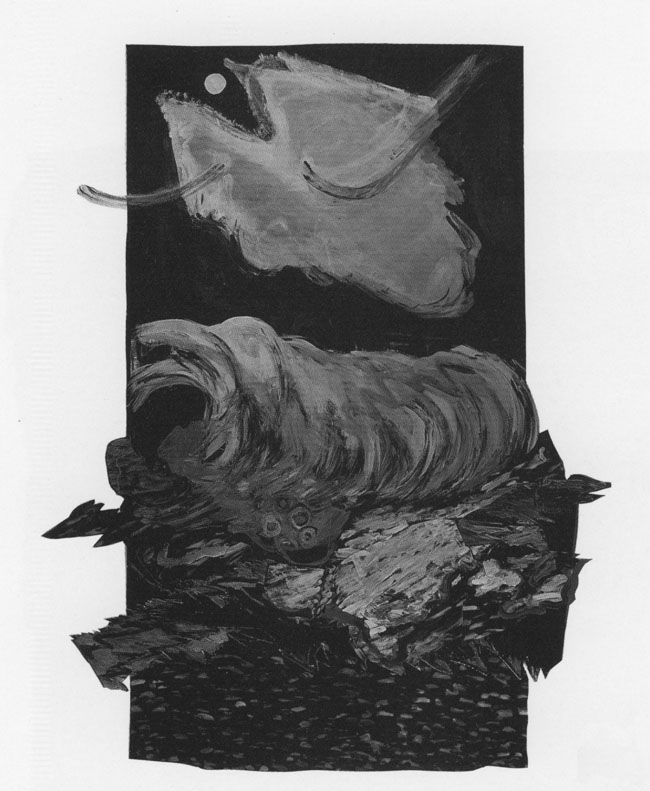Home
Artist's Statement
Recent Work
Older Work
Recognition
C.V.
Contact
Explosions of Recognition
Grace Glueck

Wave & Moon, 1985. Acrylic, pastel, collage on paper. 54" x 72".
Marcia King's exuberant paintings can hardly contain themselves. Sometimes they spill prodigally off the wall, as in the case of "Springs Upstate," a view of a woodland stream pent up by an extravagant Edwardian frame. But by means of carved Styrofoam worked into a semblance of running water, the painting escapes, flowing onto the floor, out the door and into a sewer.
It thus dramatically addresses a pressing environmental concern: our water supply and what we are doing to it. By "activating" a pastoral landscape, King-whose approach to her work is passionate, tempered by playful-invites the normally passive viewer to wade into the problem!
If the concept is slightly outrageous, it's all of a piece with King's view of the late 20th century art establishment as too rigid and intellectualized. "I feel that another side of art is not being pursued in New York," she says. "I believe that the human spirit wants to transcend, but I've always considered humor transcendant, too-something that makes the spirit soar. It's almost a dictum that you can't have art like this; it has to scold you or fix you up in some way."
Gifted with an agile line and a robust sense of color, King charms the viewer into her animated cosmos-a beach at the Hamptons where she has a home; her mother (in the guise of a Renaissance dignitary), the last days of an aging dog to whom she was fiercely attached-by means of vigorous brushwork, a brazen palette and inventive framing. She looks for the energy in a subject, the "explosions and nerve endings" as she puts it. In "Richard's Overview," a landscape near a friend's house in East Hampton that might be a bland composition in someone else's hands is made by King into a scene of theatrical intensity, with a throbbing sea, a beach of hot yellow sand and a moving wall of mauve clouds.
"I've always worked from clues of motion," King says. "The winds blowing, the clouds scudding, the passage of a person through the world." Several of the paintings in the show reflect her admiration for Hokusai's great print, "Wave at Kanagawa"-a powerful, tensely curled breaker that rears above a stormy sea-as a symbol of nature's "high organizing energy." Her work also puts one in mind of Gerard Manley Hopkin's poem, "Pied Beauty," which praises such earthly treasures as "dappled things," "skies of couple colour," "all things counter, original, spare, strange."
The sensuousness of King's brushstrokes are enhanced by a working process that she calls "onceremoved painting." She paints first on a sheet of Plexiglass; then presses it onto a prepared canvas. Squeezed against the canvas surface, the wet pigment tends to spread, producing expressive blobs of color. Many pressings and reworkings later, the painting's surface is richly layered, seductively inviting the viewer's exploration.
The tour-de-force frames with which King embellishes her canvases more often than not relate to the paintings' themes. "The Tyranny of the Garden," for instance, a lush, jungly painting of antic plants, flowers and red grass inspired by Bosch's "Garden of Earthly Delights," sports a frame of equal excess, dripping gourds, potatoes, plantains and other vegetative matter. "Gray Wave," a comber on the verge of breaking, is surrounded by a frame of regimented shell-like forms that effloresce into a cluster at the lower right.
For King the frame is an active part of the painting, a carefully crafted proscenium arch that helps the viewer suspend his disbelief. "The painting is supposed to be theatrical and seductive," she says. "And the frame invites you to abandon your inhibitions and enter."
The combination of high and low in King's work, her willing fusion of craft and art, her mating of humor with passion, her conveyance of angst and celebration, give her a vivid presence in an art world that too often ranks theory over substance.
GRACE GLUECK

Wave & Teeth, 1985. Acrylic, pastel, modeling paste on paper. 54" x 72".
Site created by Seale Studios